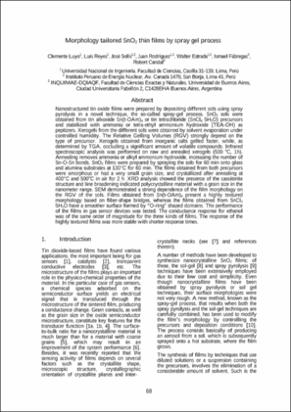Mostrar el registro sencillo del ítem
Morphology tailored SnO2 thin films by spray gel process
| dc.contributor.author | Luyo, Clemente | |
| dc.contributor.author | Reyes, Luis | |
| dc.contributor.author | Solís, José | |
| dc.contributor.author | Rodríguez, Juan | |
| dc.contributor.author | Estrada, Walter | |
| dc.contributor.author | Fábregas, Ismael | |
| dc.contributor.author | Candal, Robert | |
| dc.creator | Estrada, Walter | |
| dc.creator | Candal, Robert | |
| dc.creator | Fábregas, Ismael | |
| dc.creator | Reyes, Luis | |
| dc.creator | Rodríguez, Juan | |
| dc.creator | Luyo, Clemente | |
| dc.creator | Solís, José | |
| dc.date.accessioned | 2015-08-20T17:33:18Z | |
| dc.date.available | 2015-08-20T17:33:18Z | |
| dc.date.issued | 2006-07 | |
| dc.identifier.citation | Luyo C, Reyes L, et al. Morphology tailored SnO2 thin films by spray gel process. Informe Científico Tecnológico. Volumen 5 (2005) p. 68-76. | es_PE |
| dc.identifier.issn | 1684-1662 | |
| dc.identifier.uri | https://hdl.handle.net/20.500.13054/458 | |
| dc.description.abstract | Nanostructured tin oxide films were prepared by depositing different sols using spray pyrolysis in a novel technique, the so-called spray-gel process. SnO2 sols were obtained from tin alkoxide Sn(t-OAm)4 or tin tetrachloride (SnCl4 5H2O) precursors and stabilized with ammonia or tetra-ethyl ammonium hydroxide (TEA-OH) as peptizers. Xerogels from the different sols were obtained by solvent evaporation under controlled humidity. The Relative Gelling Volumes (RGV) strongly depend on the type of precursor. Xerogels obtained from inorganic salts gelled faster, while, as determined by TGA, occluding a significant amount of volatile compounds. Infrared spectroscopic analysis was performed on raw and annealed xerogels (500 °C, 1h). Annealing removes ammonia or alkyl ammonium hydroxide, increasing the number of Sn-O-Sn bonds. SnO2 films were prepared by spraying the sols for 60 min onto glass and alumina substrates at 130 °C for 60 min. The films obtained from both precursors were amorphous or had a very small grain size, and crystallized after annealing at 400 °C and 500 °C in air for 2 h. XRD analysis showed the presence of the cassiterite structure and line broadening indicated polycrystalline material with a grain size in the nanometer range. SEM demonstrated a strong dependence of the film morphology on the RGV of the sols. Films obtained from Sn(t-OAm)4 present a highly textured morphology based on fiber-shape bridges, whereas the films obtained from SnCl4 5H2O have a smoother surface formed by "O-ring" shaped domains. The performance of the films in gas sensor devices was tested. The conductance response for ethanol was of the same order of magnitude for the three kinds of films. The response of the highly textured films was more stable with shorter response times. | es_PE |
| dc.description.sponsorship | This work was financially supported by the International Program for Physical Science of Uppsala University, Sweden (IPPS), the Research Institute of Universidad Nacional de Ingeniería, the CONCYTEC (Peruvian Research Council), University of Buenos Aires (UBACyT; TX 117), ANPCyT (Agencia Nacional de Promoción de Ciencia y Tecnología) PICT 10621 and CYTED network VIII-G. | |
| dc.format | application/pdf | es_PE |
| dc.language.iso | eng | es_PE |
| dc.publisher | Lima (Perú) | es_PE |
| dc.rights | info:eu-repo/semantics/openAccess | es_PE |
| dc.source | Instituto Peruano de Energía Nuclear | es_PE |
| dc.source | Repositorio Institucional del Instituto Peruano de Energía Nuclear | es_PE |
| dc.subject | Óxidos de estaño | es_PE |
| dc.subject | Capas finas | es_PE |
| dc.subject | Pulverización | es_PE |
| dc.subject | Geles | es_PE |
| dc.title | Morphology tailored SnO2 thin films by spray gel process | es_PE |
| dc.type | info:eu-repo/semantics/article | es_PE |
| dc.publisher.country | PE | es_PE |





